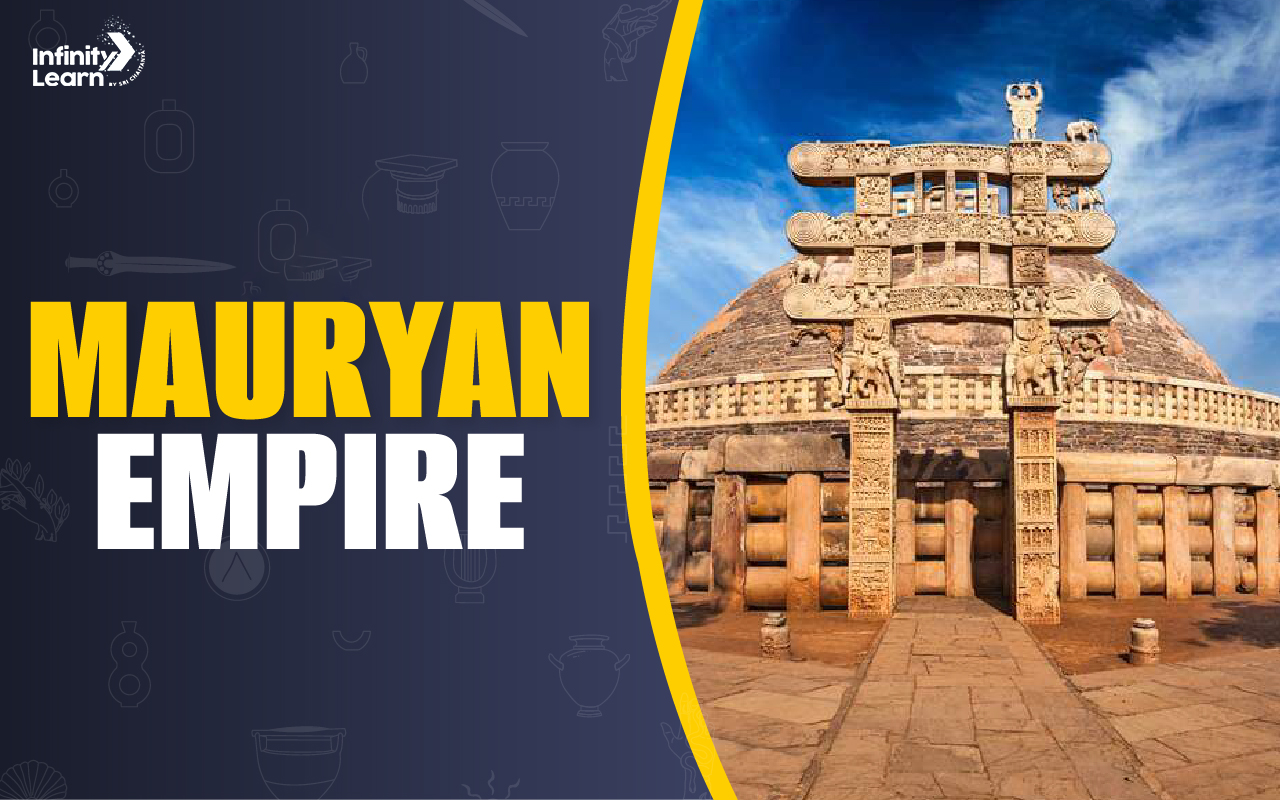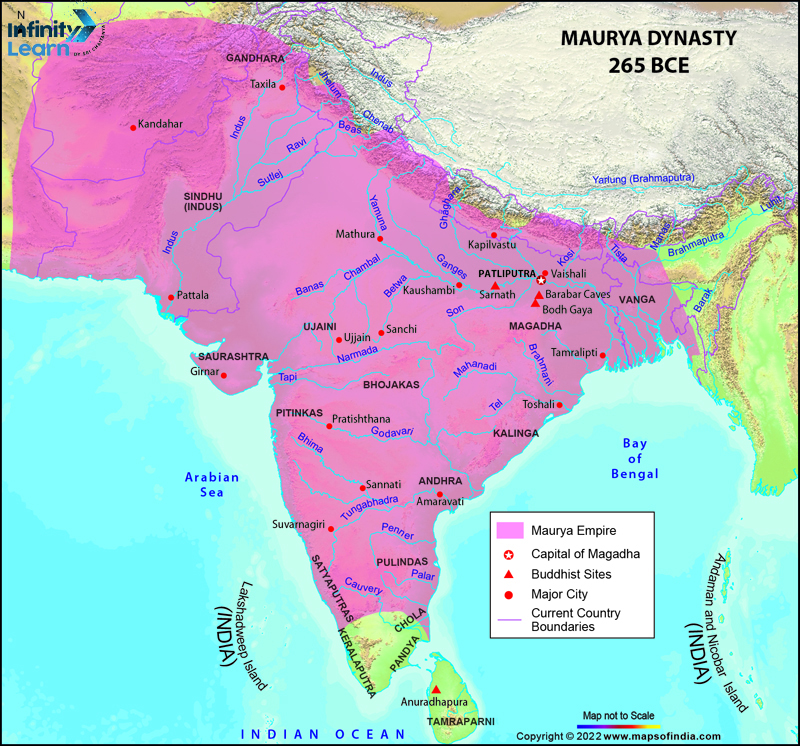Table of Contents
In ancient India, the Mauryan Empire stood as one of the most influential kingdoms, shaping the country’s rich history. Founded by the legendary king Chandragupta Maurya, this empire left an indelible mark on Indian civilization.
History of the Maurya Empire
The Maurya Empire was a major kingdom in ancient India that lasted from around 322 BCE to 185 BCE. It was started by Chandragupta Maurya, who became king under the guidance of his wise teacher, Chanakya. Together, they defeated the old rulers of the Nanda dynasty, and created the Maurya Empire.
Chandragupta Maurya expanded the empire a lot, especially towards the northwest of India. He also beat a Greek king named Seleucus I Nicator, who ruled some of the major lands. This victory made the Maurya Empire even stronger and allowed them to have friendly relations with Greek kingdoms.
Under Ashoka’s rule, the Maurya Empire became really big, stretching from Afghanistan to Bangladesh. He spread Buddhism and talked about peace and kindness through pillars and writings across the empire.
After Ashoka, the Maurya Empire slowly weakened because of fights between rulers and attacks from outside. Eventually, it broke apart into smaller kingdoms.
Even though the Maurya Empire ended, it left behind many things like new ways of ruling, beautiful buildings, and art that we can still see today. It was an important time in India’s history, showing us how powerful and influential ancient kingdoms could be.

Kings of the Mauryan Empire
The Maurya Empire was a big and important kingdom in ancient India. It started around 2,300 years ago. The king who started it was named Chandragupta Maurya. His teacher, Chanakya, guided and helped him become king. Chandragupta and his family made the Maurya Empire bigger by conquering other lands. They fought battles and won, which added more places to their kingdom. Chandragupta also fought a war against a Greek king named Seleucus. Chandragupta won and made a peace deal with Seleucus. This made the Maurya Empire even stronger.
One of the most famous kings of the Maurya Empire was Ashoka. He became king after Chandragupta. At first, Ashoka liked to fight wars to make the empire even bigger. However, after the Kalinga War, he decided not to fight wars anymore and started following the teachings of Buddhism. He wanted to be a kind and fair king and built many hospitals, roads, and other helpful things for his people.
The Maurya kings were good at ruling their empire. Chandragupta set up rules and ways to collect taxes from people. He also had spies to help him know what was happening in different parts of the empire. Ashoka added more good things, like making sure everyone
was treated well and taken care of people who were sick or hurt.
After Ashoka, the Maurya Empire started to become weaker. Other kings and rulers took over different parts of the empire, and it slowly got smaller. But even though it ended, the Maurya Empire left behind many things that we still remember today, like beautiful art, buildings, and stories about its kings. It was a very important time in India’s history, and we can still learn a lot from it.
Timeline of the Maurya Empire
- Around 321 BCE, Chandragupta Maurya starts the Maurya Empire with help from Chanakya, his teacher. They defeat the old rulers, the Nanda dynasty.
- Around 305 BCE, Chandragupta Maurya won against a Greek king named Seleucus I Nicator, making the Maurya Empire bigger.
- Around 269 BCE, Ashoka, Chandragupta’s grandson, became king after his father. He starts as a warrior but changes after seeing the suffering in a war. He starts following Buddhism.
- Around 260 BCE, Ashoka begins spreading Buddhism and focuses on peace and kindness for his people.
- Around 232 BCE, Ashoka’s reign was at its peak, and the Maurya Empire was huge, stretching from Afghanistan to Bangladesh.
- Around 232-224 BCE, Ashoka sent people to spread Buddhism to different places and put up pillars and writings about peace and tolerance.
- Around 232-224 BCE, Ashoka dies, and the Maurya Empire starts getting weaker because of fights between rulers and attacks from outside.
- Around 185 BCE: The Maurya Empire falls apart, and smaller kingdoms take over different parts of India.
Capital of Mauryan Empire
The central city and capital of the Mauryan Empire was called Pataliputra. It’s now known as Patna and is located in eastern India. This city was where the kings of the Mauryan Empire lived and ruled. It was an essential place for politics and government in ancient India.
Rulers of the Mauryan Empire
The Mauryan Empire was ruled by several kings who were very important in its history. Here are the main ones:
- Chandragupta Maurya: He was the first king of the Mauryan Empire. He started the empire with the help of his teacher, Chanakya.
- Bindusara: He was Chandragupta’s son and became king after him. Bindusara expanded the empire even more during his time as king.
- Ashoka: Ashoka is one of the most famous kings of the Mauryan Empire. He was Bindusara’s son and became king after him. Ashoka was known for his wars at first, but later, he became a follower of Buddhism and focused on peace and helping his people.
- Dasaratha Maurya: He became king after Ashoka. We only know a little about his time as king, but he ruled for a short while before someone else took over.
- Samprati: Samprati was Ashoka’s grandson and one of the last powerful kings of the Mauryan Empire. He followed Ashoka’s ideas of peace and helping people, and he also supported Jainism.
Importance of Chanakya
Chanakya, also known as Kautilya or Vishnugupta, was an ancient Indian thinker who had a big impact on Indian history. His importance lies in many areas, including politics, philosophy, and literature, which still influence Indian society today.
Political Mentor:
Chanakya was the teacher and advisor to Chandragupta Maurya, who started the Mauryan Empire. He helped Chandragupta overthrow the old rulers and create the Mauryan Empire. Chanakya’s intelligent ideas and plans were crucial for Chandragupta’s success.
Author of the Arthashastra:
Chanakya wrote a famous book called The Arthashastra. It talks about how to run a kingdom well, covering things like politics, economics, and governance. This book is still studied today and is essential for understanding ancient Indian politics.
Economic Ideas:
Chanakya also had good ideas about money and how to manage it. He believed in fair taxes and intelligent financial decisions to make a country strong and prosperous. His economic theories are still looked at and respected.
Philosophical Teachings:
Beyond politics and economics, Chanakya talked about moral values and ethical behaviour. He thought that good leaders should be honest and do what’s suitable for their people. His teachings about duty and righteousness are still valued today.
Lasting Impact:
Chanakya’s ideas and teachings continue to shape Indian society and governance. His practical approach to politics, emphasis on honesty, and insights into leadership are still relevant. His life story and teachings inspire people to be better leaders and make good choices in life.

Administration in the Mauryan Empire
The Mauryan Empire had a way of organising things to make sure everything ran smoothly. Here are some essential parts of how they did it:
- King’s Power: The king was the main boss, and he had helpers called ministers who advised him.
- Divided into Areas: The empire was split into smaller areas, each led by a governor chosen by the king. These governors looked after things like taxes and keeping order.
- Collecting Taxes: People paid taxes mainly in the form of crops they grew. There were special people in charge of collecting these taxes to make sure everyone paid their fair share.
- Strong Army: The empire had a big and strong army. Soldiers were trained well and had leaders to guide them. The army protected the empire and helped it grow by winning battles.
- Courts for Justice: There were courts where people could go to solve problems and get justice. Judges listened to both sides and made fair decisions.
- Building Roads and Bridges: The empire also worked on building things like roads, bridges, and irrigation systems. This made it easier to travel, trade, and communicate across the empire.
FAQs of the Maurya Empire
Who founded the Maurya Empire?
The Maurya Empire was founded by Chandragupta Maurya, with the help of his mentor Chanakya, around 321 BCE.
What was the capital of the Maurya Empire?
The capital of the Maurya Empire was Pataliputra, which is now known as Patna and is located in present-day Bihar, India.
Who was the most famous ruler of the Maurya Empire?
The most famous ruler of the Maurya Empire was Ashoka, also known as Ashoka the Great, who ruled from around 269 BCE to 232 BCE.
Who defeated Maurya dynasty?
The Maurya dynasty was eventually overthrown by the Sunga dynasty. After the assassination of the last Mauryan ruler, Brihadratha, in 185 BCE by his commander-in-chief Pushyamitra Sunga, the Sunga dynasty ascended to power in India.
What was the Mauryan Empire known for?
The Mauryan Empire, which flourished from around 322 BCE to 185 BCE, is renowned for several accomplishments. It was known for its vast territorial expansion under the reign of Emperor Chandragupta Maurya and his successors, notably Emperor Ashoka. The Mauryan Empire was also celebrated for its administrative innovations, including the establishment of a centralized bureaucracy and the implementation of efficient governance structures. Additionally, Emperor Ashoka's conversion to Buddhism and his subsequent efforts to spread the teachings of Buddhism, as well as his policies promoting religious tolerance and social welfare, remain significant aspects of the Mauryan legacy.









